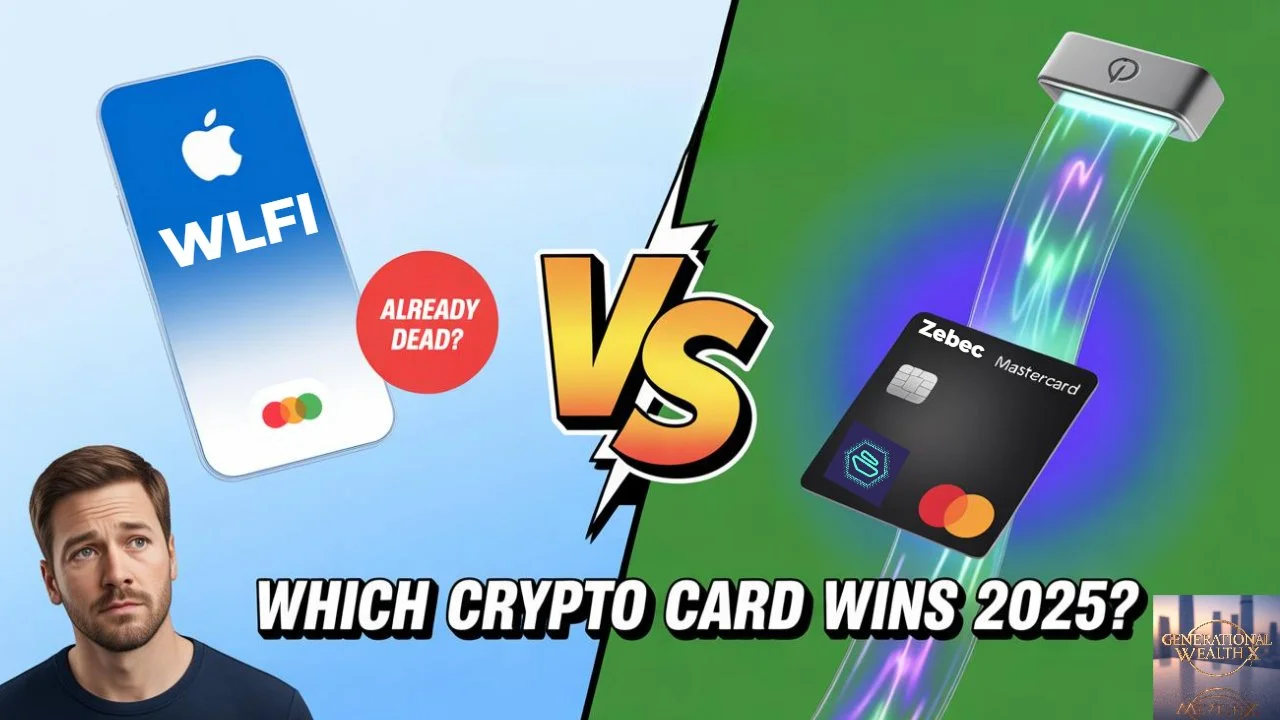Is WLFI's Crypto Card Already Obsolete Before Launch?
What if a company invested millions developing a revolutionary product, only to discover it was outdated on day one?
World Liberty Financial (WLFI) is making waves with its upcoming crypto debit card. But in the rapidly evolving cryptocurrency landscape, the technology powering your solution can determine your success or failure. While WLFI promises to bridge crypto and everyday spending with its dollar-pegged stablecoin and Apple Pay integration, another network is building an entirely different foundation for the future of digital payments.
Let's examine two competing visions for crypto payment cards—one focused on user experience, the other on revolutionary architecture—and determine which approach is truly built for longevity.
WLFI's Strategy: User Experience First
World Liberty Financial has announced a debit card for their one-dollar stablecoin, featuring seamless Apple Pay integration for effortless spending. They're developing an application described as "Venmo meets Robinhood," designed to merge simple peer-to-peer payments with cryptocurrency trading capabilities.
The Surface-Level Appeal
This approach makes strategic sense. By making crypto feel familiar and accessible, WLFI lowers the barrier to entry for mainstream adoption. However, the critical question isn't about the interface—it's about how money moves behind the scenes.
The Infrastructure Reality
WLFI has explicitly stated they will not build their own blockchain, opting instead for a "chain-agnostic" approach. This means operating on established networks like Ethereum and Solana.
The advantages:
Focus resources on user experience rather than infrastructure development
Create a bridge between decentralized finance (DeFi) and traditional commerce
Avoid the complexity of blockchain maintenance
The limitations:
Transaction speed depends entirely on host networks
Cost efficiency is constrained by underlying blockchain fees
Settlement capabilities are limited by third-party infrastructure
Technical details on achieving true decentralization remain unclear
Timeline: Pilot program launches late 2025, with full rollout planned for Q1 2026.
Zebec Network: Infrastructure-First Revolution
Zebec Network represents a fundamentally different philosophy. Rather than building another application layer, Zebec has created a payment infrastructure protocol designed specifically for next-generation finance.
Real-Time Money Streaming Explained
The core innovation is continuous value flow. Traditional finance processes payments in batches—your biweekly paycheck is a perfect example. Zebec enables second-by-second money streaming, allowing your salary to flow into your account continuously as you work.
Real-World Implementation
Zebec has already launched crypto debit cards in partnership with Mastercard. Unlike solutions that simply connect to existing systems, Zebec's entire architecture is purpose-built for instant, continuous settlement.
Head-to-Head Comparison
Transaction Speed ⚡
WLFI: Offers crypto spending through familiar interfaces, but speed is constrained by host blockchain capabilities.
Zebec: Built originally on Solana for maximum throughput, enabling genuine real-time, per-second payments that eliminate traditional settlement delays.
Cost Efficiency 💰
WLFI: Fee structure depends on underlying blockchain networks and intermediary costs.
Zebec: Streamlined on-chain protocol designed for efficiency. Their Zebec Carbon card launched as a zero-fee card.
Functionality & Innovation 🚀
WLFI: Focuses on exceptional user experience for spending and trading within familiar paradigms.
Zebec: Enables "programmable money"—complex, automated payment flows that unlock next-generation financial applications far beyond simple transactions.
Proof of Concept: Real-World Validation
Zebec isn't just theoretical innovation—they're proving their model with substantial partnerships.
The Asure Partnership
Zebec has established a joint venture with Asure, a major Human Capital Management software provider that processes over $10 billion in annual payroll for millions of U.S. employees. This partnership aims to stream payments to thousands of employees, integrating directly into the traditional economy and upgrading it from within.
Why This Matters
When a NASDAQ-listed company like Asure validates your technology, it demonstrates your infrastructure is ready for mainstream adoption. For end users, this means getting paid by the second and instantly spending that money anywhere Mastercard is accepted—a fundamental shift from current financial systems.
The Verdict: Obsolete or Just Different?
Is WLFI's crypto card obsolete before launch? "Obsolete" may be too harsh. The familiar app experience and Apple Pay integration will definitely attract users seeking a simple on-ramp to crypto spending.
However, WLFI's model faces significant challenges from more technologically advanced solutions. The future of payments isn't merely about making crypto spending easier—it's about fundamentally transforming how value moves.
Two Distinct Visions
WLFI is building a user-friendly bridge to existing systems—evolutionary improvement.
Zebec is constructing an entirely new highway—revolutionary transformation.
Networks like Zebec are pioneering real-time, continuous-flow payments that could redefine financial infrastructure. While both approaches have merit, the question becomes: which foundation will support the next decade of financial innovation?
Your Perspective Matters
What do you believe is more critical for mass adoption?
A seamless, "Venmo-like" experience that makes crypto accessible today?
Advanced payment infrastructure that enables entirely new financial possibilities?
Join the conversation by subscribing to our newsletter at
for deeper analysis of the technologies shaping tomorrow's financial landscape.
Disclaimer: This content is for educational purposes only and does not constitute financial advice. I am not a licensed financial advisor. Cryptocurrency investments are highly volatile—never invest more than you can afford to lose. Always conduct thorough research before making investment decisions.
Why Analysts Are Betting It All on ZBCN This Year
What if your earnings showed up in your account every single second you worked—no more waiting for payday, no more stress over pending deposits? While meme coins grab the headlines, crypto’s sharpest analysts are quietly watching a project that could transform how we all get paid. Meet Zebec Network (ZBCN), the “Stripe of Web3,” aiming to solve one of the biggest headaches in modern finance.
Disclaimer: This article is for educational purposes only and does not constitute financial advice. Crypto is volatile—never invest more than you can afford to lose. Always do your own research!
Why Don’t We Get Paid Instantly?
Despite living in a world of on-demand everything, our paychecks are still stuck in the slow lane. Traditional finance is clunky and expensive, built for a different era, and that means millions of people and businesses deal with constant cash flow headaches. The idea of getting paid for every second you work isn’t just a dream—Zebec is actually building it.
1. Streaming Payments: The Tech That Changes Everything 🚀
The first reason for analyst excitement? Zebec’s streaming payments technology. Imagine opening your phone and seeing your wages accumulate in real time, ready to use instantly. Zebec’s protocol allows value to flow continuously, replacing the outdated, batch-based payroll systems we’re all used to.
This isn’t just for payroll. Zebec’s tech enables micropayments, automated treasury management for businesses, and cheap, fast cross-border transfers. By building on high-speed blockchains like Solana, Zebec keeps transactions lightning-fast and affordable (no more painful gas fees!).
Why this matters:
Employees get access to their earnings as they work
Perfect for gig workers and freelancers
Businesses can automate and streamline payments
Cross-border payments become instant and low-cost
2. Real-World Adoption & Major Partnerships 🌐
Great technology is only half the battle—real adoption is where Zebec shines. The network is already processing significant payment volumes and has earned the trust of a growing list of businesses.
One of the most exciting features? Zebec’s crypto debit cards. With Silver and Black cards powered by Mastercard, users can spend their crypto anywhere Mastercard is accepted. This isn’t a future promise—it’s live right now, bringing Web3 utility into daily life.
On the partnership front, Zebec has landed some heavy hitters. In September 2025, Zebec announced a partnership with AllUnity—a venture backed by Deutsche Bank’s DWS and Galaxy Digital—to integrate the MiCA-compliant EURAU euro stablecoin. This collaboration positions Zebec as a key player in delivering real-time, stablecoin-powered payroll solutions across Europe and for global clients, connecting regulated finance with DeFi efficiency.
And that’s not all—Zebec has teamed up with World Mobile to launch ZebecNET, combining decentralized mobile connectivity with Zebec’s payment rails to expand financial access in underserved regions.
3. Catalysts for Explosive Growth 💥
Analysts are watching Zebec for some powerful reasons that could drive major price action.
First, regulatory compliance is front and center. Zebec is actively pursuing globally recognized standards like ISO certifications and SOC 2 audits, while aligning with Europe’s MiCA framework. This compliance-first approach is designed to attract institutional investors who avoid projects that aren’t above board.
Second, the ZBCN token is built with smart, deflationary tokenomics. Through buyback and burn programs, the circulating supply shrinks over time, increasing scarcity and supporting value. The fact that a large portion of the supply is staked long-term signals strong holder confidence in the project’s future.
As for price, ZBCN is trading around $0.004 as of late September 2025. Analyst targets for 2025 range from a conservative $0.006 to a bullish $0.0146, with even higher potential if Zebec’s partnerships and adoption continue to deliver.
4. Risks to Consider
No investment is risk-free, and Zebec faces real challenges. The digital payments space is crowded and competitive—Zebec isn’t just up against other crypto projects but also fintech giants like PayPal, who are making their own moves in stablecoins. Plus, the global regulatory landscape for crypto is still evolving, so new hurdles could pop up at any time. Zebec’s future depends on its ability to keep innovating and executing at a high level.
The Bottom Line
Zebec Network’s bullish case stands on three pillars: its revolutionary streaming payment technology, real-world adoption through partnerships with major players like Mastercard and AllUnity, and strong growth catalysts driven by compliance and smart tokenomics.
With its unique tech and heavyweight backers, ZBCN is positioned to grab a massive slice of the digital payments market.
What do you think?
Could Zebec hit those analyst price targets in 2025? Drop your thoughts in the comments! For more deep dives into altcoins with real-world utility, subscribe to our newsletter and join the Insiders Group at GenerationalWealth.biz.
Disclaimer: This content is for informational purposes only and should not be considered financial advice. Always do your own research before making any investment decisions.
Quick Questions for You:
Are you using any crypto payroll or payment solutions today?
What’s the biggest barrier to mainstream crypto adoption?
Which altcoin should we analyze next?
Ready to level up your crypto knowledge? Subscribe for updates and never miss a trend in building generational wealth! 🚀💸



